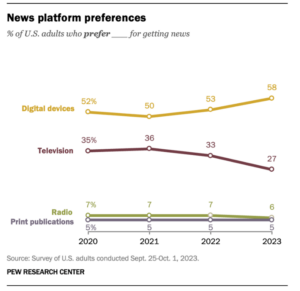admin - 08/07/2024
Learn the true definition of PR, how it’s shifting in the digital age, its importance for businesses today, and what the future holds.
The world of public relations (PR) is constantly evolving as the digital landscape continues to shift at a rapid pace. PR is a concept that people generally understand, but rarely seem to know how to define. The Public Relations Society of America (PRSA) defines it as “a strategic communication process that builds mutually beneficial relationships between organizations and their publics.” In other words, it strategically fosters communication channels between a company and its stakeholders. It’s all about sharing a brand’s messaging in engaging ways that influence public opinion and behavior and maintain relationships with stakeholders.
The growing landscape of social media content creation, Artificial Intelligence (AI), influencer marketing, and other trends have led to questions about the role of public relations in the years to come. The truth is, while the technology and platforms change, the questions companies should be considering remain the same: how can PR and social media help accomplish your business goals, and what strategies and tactics should you be leveraging to ensure your messaging is reaching, resonating with, and being remembered by its target audience?
Evolution of PR
PR, in modern terms, dates back to the 20th century, during which basic PR concepts were used to help famous individuals create their own narratives in the media and position themselves in a positive light to gain popularity. Print media was valued the most, as that’s what people relied on to obtain their news. As magazines and newspapers became part of everyday life and earned significant credibility over the years, the practice of creating press releases and pitching journalists emerged as a method of securing media coverage.
However, the digital world has transformed this concept. According to Statista, “In 2022, only 12% of the US population turned to newspapers for daily news consumption, while 37% used social media.” Furthermore, a 2023 survey from Pew Research Center revealed that under 10% of U.S adults in each demographic group say they prefer print media for getting news.

New PR Strategies
Between print outlets shifting to digital platforms, increasing rates of advertising on social media, and an ever-growing amount of content to compete with, PR strategies have had to evolve accordingly. Digital efforts are supported with content creatio: written, graphical, video or audio content for audiences aimed to capture attention. With social media platforms enabling 24/7/365 engagement, PR professionals now not only create and maintain a two-way conversation with the public, but messaging must be concise, memorable, and more specific and targeted to the audience’s interests than ever.
While the key messages within the content are important for raising awareness and sharing information, the value of direct feedback and dialogue your audience is what creates and maintains brand engagement, interest, and loyalty.
PR in the Digital Age
Digital PR aims to increase a brand’s online presence, secure coverage in online outlets, and strategically leverage social media to increase brand recognition and messaging. The blend of social media and PR has allowed for increased accessibility to journalists and to help PR professionals understand their specific areas of interest. Not only is their coverage accessible online, but journalists often promote their own work through social media, paving the way to get a better handle on the likeliness of a journalist being interested in a specific topic. (Learn more about how social media and public relations work together here.)
The implementation of social media as a PR tool allows for real-time engagement and immediate feedback, highlighting its ability to be interactive 24/7. With the help of experienced PR professionals, brands can go a step beyond reaching their audiences, now directly engaging and build relationships with them by responding to comments and addressing their needs, while keeping the brands’ goals in mind. Social media is also an affordable and effective tool for promoting events. Even paid social campaigns do not require a large budget, and when the content delivers the right messaging to the right audience, can be as, if not more, effective than traditional PR methods. Often, a combination of traditional and digital PR yields the best results. This summer, for example, when Westfield Garden State Plaza—one of New Jersey’s oldest and largest shopping malls—hosted the Pop 2000 Tour concert, the 3E PR team leveraged traditional and digital tactics to generate buzz and drive event traffic. We alerted the media with a press release, secured calendar event listings in regional media outlets, promoted the event via the mall’s social media channels, partnered with targeted influencers to amplify awareness, and created interactive behind-the-scenes and concert content before, during and after the show. The blend of traditional and digital PR strategies has evolved to stay relevant.
Current Trends in PR
Social Media Metrics
No matter what platform a brand uses for its content, gaining data-driven insights based on social media analytics is crucial. On a fundamental level, PR professionals use this data to see which types of content are gaining the most engagement and adjust their strategies from there to ensure all content is targeted. Demographic information, consumer behavior, and patterns are all valuable insights. Analyzing data such as KPIs (Key Performance Indicators), sentiment analysis, engagement rates, and shares further helps to assess the success of their work.
Visual Storytelling
 Knowing how to properly leverage visual storytelling techniques, such as videos, infographics, and photos, is a required skill for any PR marketing professional today. According to Sprinklr, “A remarkable 74% of users take action after viewing a brand’s video on Instagram. This includes visiting a website, making a purchase, or sharing the content with their network”. Videos and graphics help strengthen a brand’s message and make it simple yet memorable. Graphics can simply capture complex ideas, create an emotional connection, and enhance information processing. Critical components of visuals include colors that evoke emotion, relevant context, and unique layouts. It’s also important to ensure that visuals created over time maintain consistency to build brand identity.
Knowing how to properly leverage visual storytelling techniques, such as videos, infographics, and photos, is a required skill for any PR marketing professional today. According to Sprinklr, “A remarkable 74% of users take action after viewing a brand’s video on Instagram. This includes visiting a website, making a purchase, or sharing the content with their network”. Videos and graphics help strengthen a brand’s message and make it simple yet memorable. Graphics can simply capture complex ideas, create an emotional connection, and enhance information processing. Critical components of visuals include colors that evoke emotion, relevant context, and unique layouts. It’s also important to ensure that visuals created over time maintain consistency to build brand identity.
Influencer Marketing and Influencer Relations
Influencers have come to play a significant role in public relations throughout the rise of social media and are best utilized in a few ways. Just as the digital age has provided PR professionals with more information and accessibility to journalists, we can also research and connect with key influencers to help create content or participate in campaigns that fit clients’ needs. Just as there are different types of influencers, there are also different ways in which to partner with them. Case in point: influencer marketing versus influencer relations. They sound similar but are quite different in terms of strategy and execution.
Influencer marketing involves forging a partnership between a brand and an influencer for a specific social media campaign or objective. During these campaigns, influencers are compensated to create and post certain content for a brand to strategically elicit awareness, excitement, engagement, and any number of other actions from their followers. Influencer relations is more focused on building a long-term, genuine relationships with an influencer who, ideally, would authentically integrate the brand into their content. This strategy helps to foster trust and credibility. Having a PR partner who can help guide brands in what type of program or influencer fits their objectives maximizes the power of working with influencers.
Future of PR
A few predictions about how PR will evolve in the future:
Compelling storytelling will continue to be a key factor in earning and retaining audience attention.
PR professionals will continue adopting even more personalized and targeted approaches to communicating with target audiences, identifying the most compelling ways to implement tailored messaging.
Using predictive analytics and other AI tools will become standard practice for things like transcribing interviews, gathering data insights, identifying influencers, and streamlining content creation—but only PR professionals who know how to leverage them properly will harness their full potential. (Learn more about AI and PR Agencies here.)
Importance of PR
PR Professionals and brands alike benefit in new and meaningful ways as these new tools aid in reaching and connecting with target audiences. More authentic relationships can be built by PR professionals, which will lead to success with brand engagement, reputation, and visibility.
The media landscape will continue to change and grow, and with the right PR support and guidance, brands can use these tools, technologies, and strategies to grow with it.
Author
This guest blog was written by 3E PR intern Rena Lerner.
